Recruitment and Selection Report: Strategies for a Diverse Workforce
VerifiedAdded on 2022/10/19
|28
|7940
|430
Report
AI Summary
This report, focusing on recruitment and selection within a global context, provides a comprehensive overview of key HR practices. It begins by exploring the organizational benefits of a diverse workforce and the factors influencing talent planning, recruitment, and selection policies. The report then delves into various recruitment and selection methods, including job portals, agencies, interviews, and selection tests, alongside their appropriate applications. A significant portion is dedicated to developing a job description and person specification for an HR generalist role, followed by crafting recruitment materials, shortlisting candidates, and conducting interviews. The report also covers the importance of record retention and provides examples of appointment and non-appointment letters. Finally, it examines the purpose, benefits, and areas to be covered in induction training for new employees, emphasizing its role in fostering a welcoming and productive work environment. The report concludes by highlighting the value of diversity in the workplace, the impact of various factors on global HR approaches, and the legal requirements surrounding recruitment records.

Running Head: TITLE OF THE ASSIGNMENT 1
Recruitment and Selection
Recruitment and Selection
Paraphrase This Document
Need a fresh take? Get an instant paraphrase of this document with our AI Paraphraser
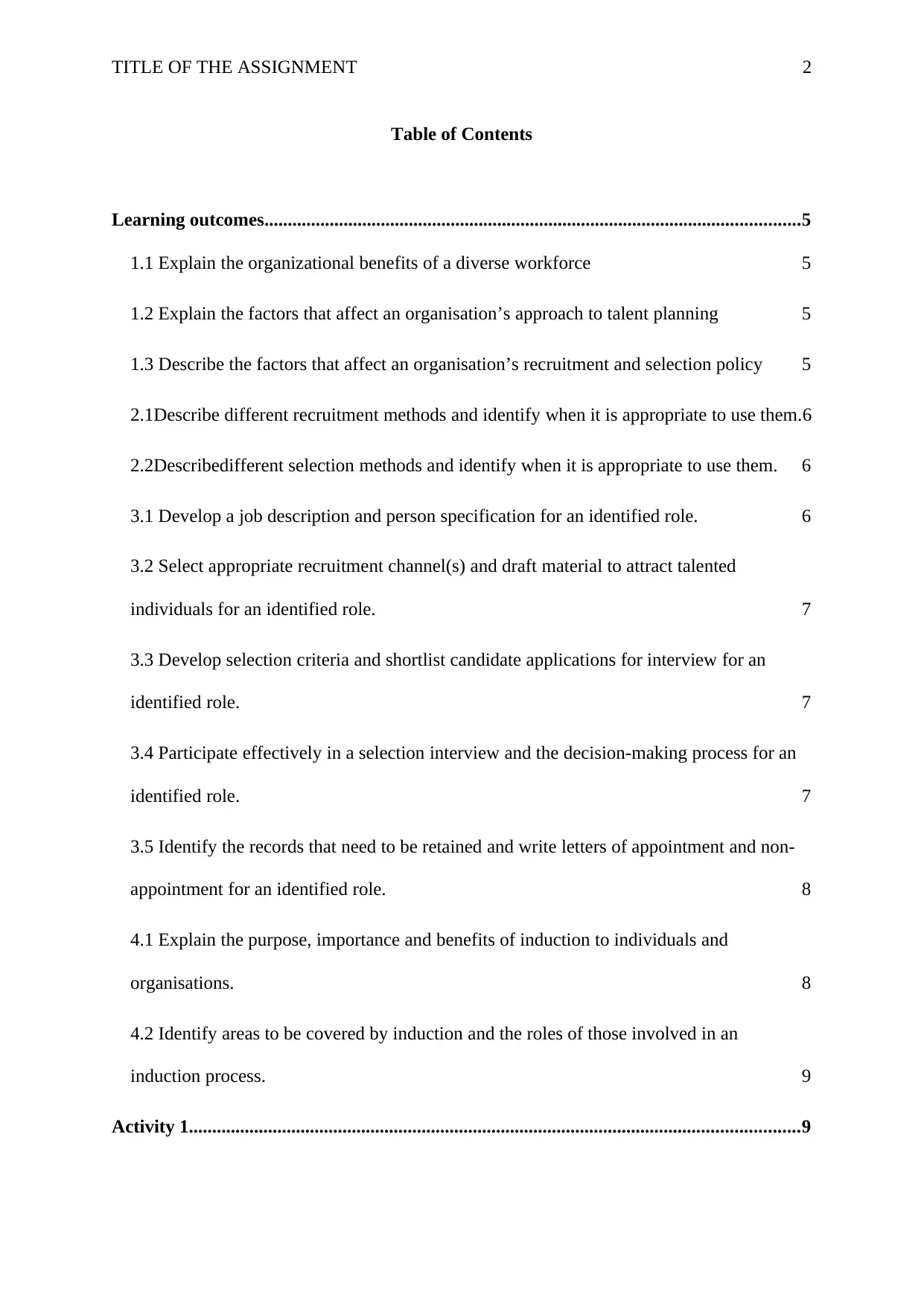
TITLE OF THE ASSIGNMENT 2
Table of Contents
Learning outcomes...................................................................................................................5
1.1 Explain the organizational benefits of a diverse workforce 5
1.2 Explain the factors that affect an organisation’s approach to talent planning 5
1.3 Describe the factors that affect an organisation’s recruitment and selection policy 5
2.1Describe different recruitment methods and identify when it is appropriate to use them.6
2.2Describedifferent selection methods and identify when it is appropriate to use them. 6
3.1 Develop a job description and person specification for an identified role. 6
3.2 Select appropriate recruitment channel(s) and draft material to attract talented
individuals for an identified role. 7
3.3 Develop selection criteria and shortlist candidate applications for interview for an
identified role. 7
3.4 Participate effectively in a selection interview and the decision-making process for an
identified role. 7
3.5 Identify the records that need to be retained and write letters of appointment and non-
appointment for an identified role. 8
4.1 Explain the purpose, importance and benefits of induction to individuals and
organisations. 8
4.2 Identify areas to be covered by induction and the roles of those involved in an
induction process. 9
Activity 1...................................................................................................................................9
Table of Contents
Learning outcomes...................................................................................................................5
1.1 Explain the organizational benefits of a diverse workforce 5
1.2 Explain the factors that affect an organisation’s approach to talent planning 5
1.3 Describe the factors that affect an organisation’s recruitment and selection policy 5
2.1Describe different recruitment methods and identify when it is appropriate to use them.6
2.2Describedifferent selection methods and identify when it is appropriate to use them. 6
3.1 Develop a job description and person specification for an identified role. 6
3.2 Select appropriate recruitment channel(s) and draft material to attract talented
individuals for an identified role. 7
3.3 Develop selection criteria and shortlist candidate applications for interview for an
identified role. 7
3.4 Participate effectively in a selection interview and the decision-making process for an
identified role. 7
3.5 Identify the records that need to be retained and write letters of appointment and non-
appointment for an identified role. 8
4.1 Explain the purpose, importance and benefits of induction to individuals and
organisations. 8
4.2 Identify areas to be covered by induction and the roles of those involved in an
induction process. 9
Activity 1...................................................................................................................................9

TITLE OF THE ASSIGNMENT 3
Identifying and explaining 3 organisational benefits of attracting and retaining a diverse
and global workforce 9
Identifying and explaining 4 factors that affect a global organisation’s approach to
attracting talent 10
Describing 3 factors that affect a global organisation’s approach to recruitment and
selection 11
Describing the benefits of 3 different recruitment methods and 3 different selection
methods and when it would be appropriate for a global organisation to use them 11
Activity 2.................................................................................................................................12
Designing a job description and person specification for global generalist HR role 12
Compiling a suitable job profile/brief/advert for your recruitment campaign 14
Producing a short-listing matrix 15
Activity 3.................................................................................................................................18
Conducting an interview with your preferred candidate and deciding on whether to appoint
or not and justifying that decision 18
A suitable method to record the notes from the interview e.g. an Interview matrix and
scoring system 21
Compiling a letter for the successful candidate offering them the role and a letter to
unsuccessful candidates 21
Providing written detail of the legal requirements for retaining and storing recruitment
records on completion of the recruitment drive 23
Activity 4.................................................................................................................................24
Introduction 24
Identifying and explaining 3 organisational benefits of attracting and retaining a diverse
and global workforce 9
Identifying and explaining 4 factors that affect a global organisation’s approach to
attracting talent 10
Describing 3 factors that affect a global organisation’s approach to recruitment and
selection 11
Describing the benefits of 3 different recruitment methods and 3 different selection
methods and when it would be appropriate for a global organisation to use them 11
Activity 2.................................................................................................................................12
Designing a job description and person specification for global generalist HR role 12
Compiling a suitable job profile/brief/advert for your recruitment campaign 14
Producing a short-listing matrix 15
Activity 3.................................................................................................................................18
Conducting an interview with your preferred candidate and deciding on whether to appoint
or not and justifying that decision 18
A suitable method to record the notes from the interview e.g. an Interview matrix and
scoring system 21
Compiling a letter for the successful candidate offering them the role and a letter to
unsuccessful candidates 21
Providing written detail of the legal requirements for retaining and storing recruitment
records on completion of the recruitment drive 23
Activity 4.................................................................................................................................24
Introduction 24
⊘ This is a preview!⊘
Do you want full access?
Subscribe today to unlock all pages.

Trusted by 1+ million students worldwide
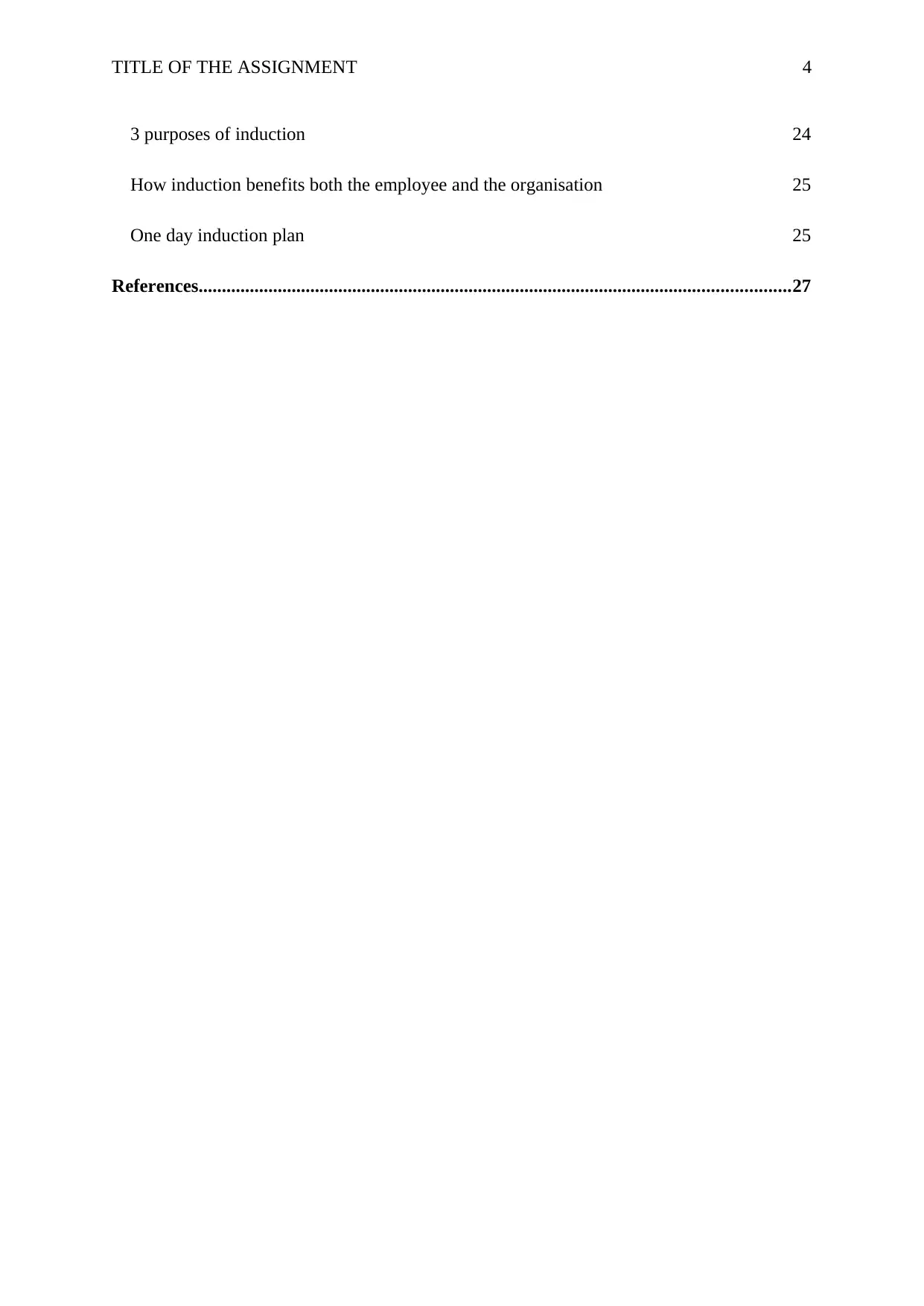
TITLE OF THE ASSIGNMENT 4
3 purposes of induction 24
How induction benefits both the employee and the organisation 25
One day induction plan 25
References...............................................................................................................................27
3 purposes of induction 24
How induction benefits both the employee and the organisation 25
One day induction plan 25
References...............................................................................................................................27
Paraphrase This Document
Need a fresh take? Get an instant paraphrase of this document with our AI Paraphraser
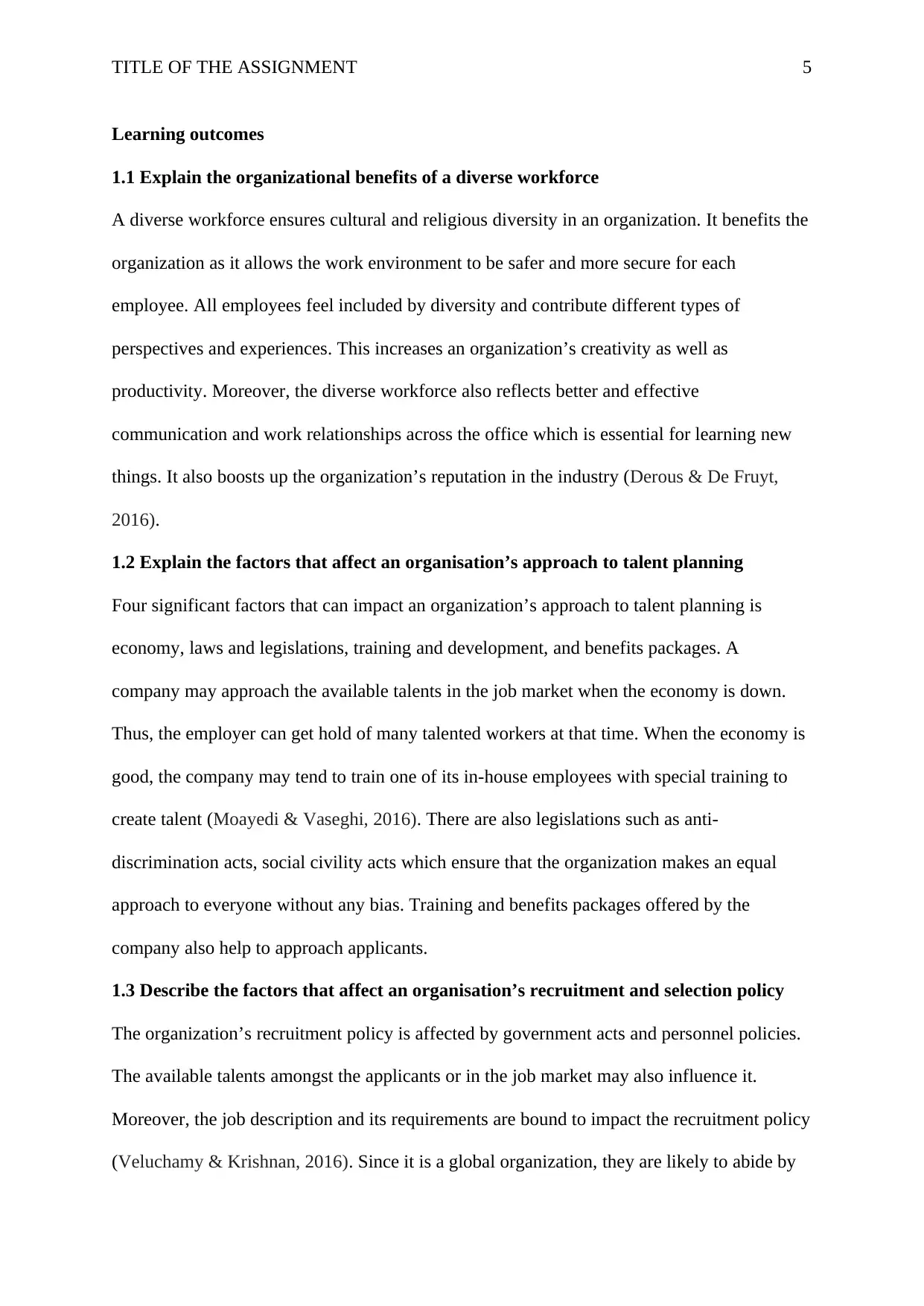
TITLE OF THE ASSIGNMENT 5
Learning outcomes
1.1 Explain the organizational benefits of a diverse workforce
A diverse workforce ensures cultural and religious diversity in an organization. It benefits the
organization as it allows the work environment to be safer and more secure for each
employee. All employees feel included by diversity and contribute different types of
perspectives and experiences. This increases an organization’s creativity as well as
productivity. Moreover, the diverse workforce also reflects better and effective
communication and work relationships across the office which is essential for learning new
things. It also boosts up the organization’s reputation in the industry (Derous & De Fruyt,
2016).
1.2 Explain the factors that affect an organisation’s approach to talent planning
Four significant factors that can impact an organization’s approach to talent planning is
economy, laws and legislations, training and development, and benefits packages. A
company may approach the available talents in the job market when the economy is down.
Thus, the employer can get hold of many talented workers at that time. When the economy is
good, the company may tend to train one of its in-house employees with special training to
create talent (Moayedi & Vaseghi, 2016). There are also legislations such as anti-
discrimination acts, social civility acts which ensure that the organization makes an equal
approach to everyone without any bias. Training and benefits packages offered by the
company also help to approach applicants.
1.3 Describe the factors that affect an organisation’s recruitment and selection policy
The organization’s recruitment policy is affected by government acts and personnel policies.
The available talents amongst the applicants or in the job market may also influence it.
Moreover, the job description and its requirements are bound to impact the recruitment policy
(Veluchamy & Krishnan, 2016). Since it is a global organization, they are likely to abide by
Learning outcomes
1.1 Explain the organizational benefits of a diverse workforce
A diverse workforce ensures cultural and religious diversity in an organization. It benefits the
organization as it allows the work environment to be safer and more secure for each
employee. All employees feel included by diversity and contribute different types of
perspectives and experiences. This increases an organization’s creativity as well as
productivity. Moreover, the diverse workforce also reflects better and effective
communication and work relationships across the office which is essential for learning new
things. It also boosts up the organization’s reputation in the industry (Derous & De Fruyt,
2016).
1.2 Explain the factors that affect an organisation’s approach to talent planning
Four significant factors that can impact an organization’s approach to talent planning is
economy, laws and legislations, training and development, and benefits packages. A
company may approach the available talents in the job market when the economy is down.
Thus, the employer can get hold of many talented workers at that time. When the economy is
good, the company may tend to train one of its in-house employees with special training to
create talent (Moayedi & Vaseghi, 2016). There are also legislations such as anti-
discrimination acts, social civility acts which ensure that the organization makes an equal
approach to everyone without any bias. Training and benefits packages offered by the
company also help to approach applicants.
1.3 Describe the factors that affect an organisation’s recruitment and selection policy
The organization’s recruitment policy is affected by government acts and personnel policies.
The available talents amongst the applicants or in the job market may also influence it.
Moreover, the job description and its requirements are bound to impact the recruitment policy
(Veluchamy & Krishnan, 2016). Since it is a global organization, they are likely to abide by

TITLE OF THE ASSIGNMENT 6
all the legal requirements while shaping their recruitment policy such as anti-discrimination
and employment equality acts.
2.1Describe different recruitment methods and identify when it is appropriate to use
them.
Different types of recruitment methods involve recruitment agencies, online job portals or job
boards and press marketing. Online job portals are effective in terms of both time and money
(Wahyuningtyas, 2015). It helps to reach a global pool of talents and receive applicants from
all over the world. Press marketing is useful to aware people about the organization and its
activities. A recruitment agency is also effective as most of the recruitment processes are
done by the agency. Thus the company can be assured that the procedures are being followed
properly and it saves time. When a company wants to create a diverse workforce, an online
job portal is useful.
2.2Describedifferent selection methods and identify when it is appropriate to use them.
Interview, selection tests, and group activities are three different types of the selection
method. In selection tests, it is impossible for the interviewer to judge a candidate with any
bias and only judge them by their performance in the test (Uddin & Arif, 2016). The
interviewer can observe the candidates’ behavior, attitude and ability to manage a stressful
situation. In the interview round, the candidates are asked questions with more details. This is
helpful to understand which employee is serious about the opportunity as well as who will be
most suitable.
3.1 Develop a job description and person specification for an identified role.
HR generalist is being hired by the Schindler Tech Inc. the organization is spread globally.
Therefore, the applicants must be willing to travel and relocate as per company’s
requirements. The generalist will work under the HR manager and will report to him. The
employee will be responsible for overseeing the daily activities and performance of all
all the legal requirements while shaping their recruitment policy such as anti-discrimination
and employment equality acts.
2.1Describe different recruitment methods and identify when it is appropriate to use
them.
Different types of recruitment methods involve recruitment agencies, online job portals or job
boards and press marketing. Online job portals are effective in terms of both time and money
(Wahyuningtyas, 2015). It helps to reach a global pool of talents and receive applicants from
all over the world. Press marketing is useful to aware people about the organization and its
activities. A recruitment agency is also effective as most of the recruitment processes are
done by the agency. Thus the company can be assured that the procedures are being followed
properly and it saves time. When a company wants to create a diverse workforce, an online
job portal is useful.
2.2Describedifferent selection methods and identify when it is appropriate to use them.
Interview, selection tests, and group activities are three different types of the selection
method. In selection tests, it is impossible for the interviewer to judge a candidate with any
bias and only judge them by their performance in the test (Uddin & Arif, 2016). The
interviewer can observe the candidates’ behavior, attitude and ability to manage a stressful
situation. In the interview round, the candidates are asked questions with more details. This is
helpful to understand which employee is serious about the opportunity as well as who will be
most suitable.
3.1 Develop a job description and person specification for an identified role.
HR generalist is being hired by the Schindler Tech Inc. the organization is spread globally.
Therefore, the applicants must be willing to travel and relocate as per company’s
requirements. The generalist will work under the HR manager and will report to him. The
employee will be responsible for overseeing the daily activities and performance of all
⊘ This is a preview!⊘
Do you want full access?
Subscribe today to unlock all pages.

Trusted by 1+ million students worldwide

TITLE OF THE ASSIGNMENT 7
employees (Rabbi et al., 2015). The major job responsibility involves conducting training
sessions for employees to educate, introduce new policies and explain existing policies along
with training the employees for effective communication.
The position requires a person with a bachelor's degree in HR and be trained in the same field
along with 3-5 years of work experience.
3.2 Select appropriate recruitment channel(s) and draft material to attract talented
individuals for an identified role.
The organization will be opting for a recruitment campaign that will be posted online on
professional job networks such as LinkedIn, MeetUp, etc. the employee is required to have
all documents and certifications necessary for acquiring the job. Traveling will be a part of
the job. Therefore, the person must be willing to relocate when necessary. Apart from that, a
person must have communication and interpersonal skills. In exchange, the company will
provide fair compensation to the employee along with flexible packages. There is also an
opportunity to get a promotion in this company. The company will also compensate the
employee with allowance and accommodation as support in case of relocation.
3.3 Develop selection criteria and shortlist candidate applications for interview for an
identified role.
Selection criteria for the interviewees are education qualification, professional experience,
knowledge, and skills, cultural awareness, characteristics such as motivated, enthusiastic,
ability to perform in stress, etc. as per the applications received, only one candidate has been
selected for the final interview – candidate 2. She matches all the criteria of educational and
professional qualification, work experience, knowledge and skills and cultural awareness for
diversity.
3.4 Participate effectively in a selection interview and the decision-making process for
an identified role.
employees (Rabbi et al., 2015). The major job responsibility involves conducting training
sessions for employees to educate, introduce new policies and explain existing policies along
with training the employees for effective communication.
The position requires a person with a bachelor's degree in HR and be trained in the same field
along with 3-5 years of work experience.
3.2 Select appropriate recruitment channel(s) and draft material to attract talented
individuals for an identified role.
The organization will be opting for a recruitment campaign that will be posted online on
professional job networks such as LinkedIn, MeetUp, etc. the employee is required to have
all documents and certifications necessary for acquiring the job. Traveling will be a part of
the job. Therefore, the person must be willing to relocate when necessary. Apart from that, a
person must have communication and interpersonal skills. In exchange, the company will
provide fair compensation to the employee along with flexible packages. There is also an
opportunity to get a promotion in this company. The company will also compensate the
employee with allowance and accommodation as support in case of relocation.
3.3 Develop selection criteria and shortlist candidate applications for interview for an
identified role.
Selection criteria for the interviewees are education qualification, professional experience,
knowledge, and skills, cultural awareness, characteristics such as motivated, enthusiastic,
ability to perform in stress, etc. as per the applications received, only one candidate has been
selected for the final interview – candidate 2. She matches all the criteria of educational and
professional qualification, work experience, knowledge and skills and cultural awareness for
diversity.
3.4 Participate effectively in a selection interview and the decision-making process for
an identified role.
Paraphrase This Document
Need a fresh take? Get an instant paraphrase of this document with our AI Paraphraser
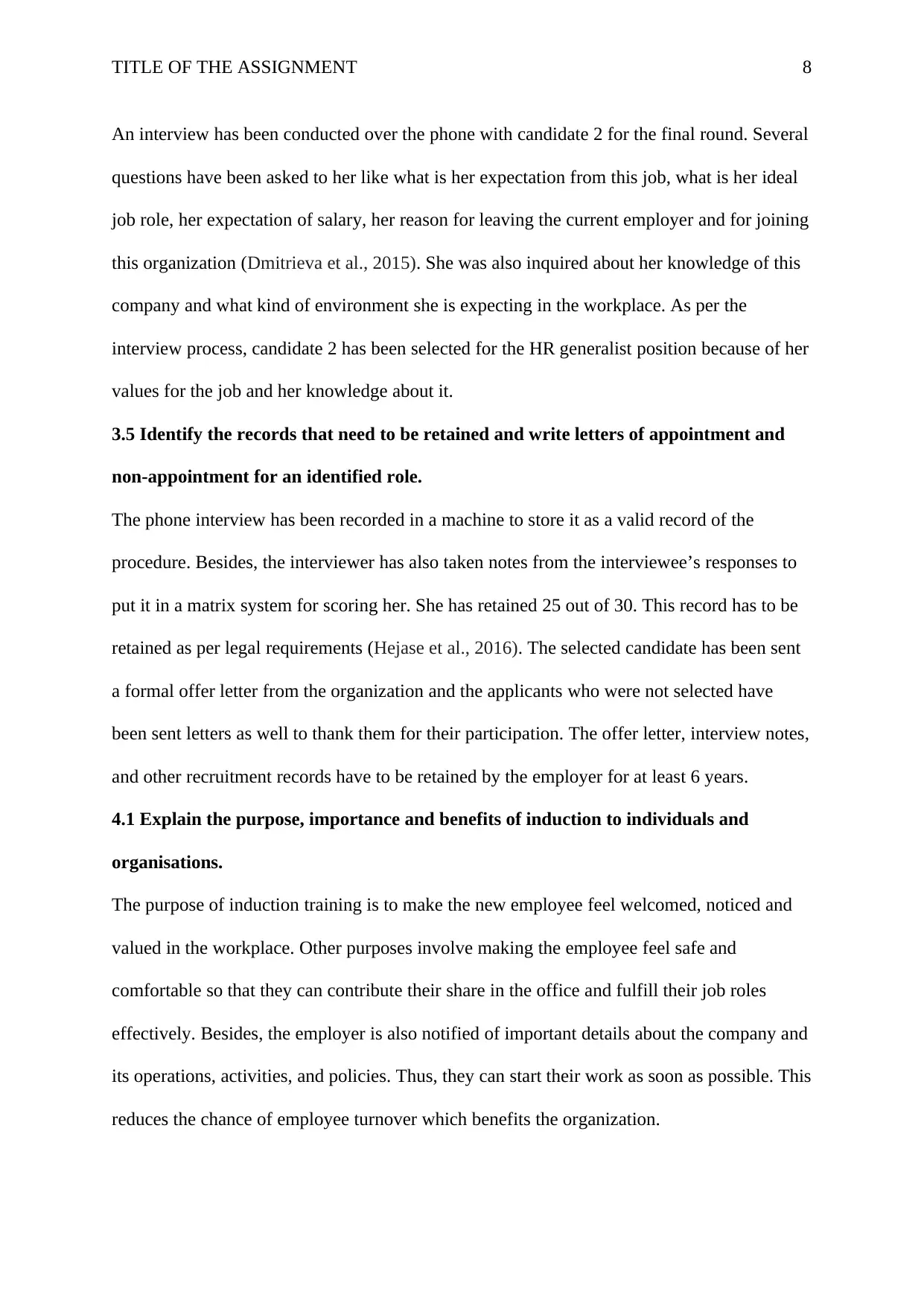
TITLE OF THE ASSIGNMENT 8
An interview has been conducted over the phone with candidate 2 for the final round. Several
questions have been asked to her like what is her expectation from this job, what is her ideal
job role, her expectation of salary, her reason for leaving the current employer and for joining
this organization (Dmitrieva et al., 2015). She was also inquired about her knowledge of this
company and what kind of environment she is expecting in the workplace. As per the
interview process, candidate 2 has been selected for the HR generalist position because of her
values for the job and her knowledge about it.
3.5 Identify the records that need to be retained and write letters of appointment and
non-appointment for an identified role.
The phone interview has been recorded in a machine to store it as a valid record of the
procedure. Besides, the interviewer has also taken notes from the interviewee’s responses to
put it in a matrix system for scoring her. She has retained 25 out of 30. This record has to be
retained as per legal requirements (Hejase et al., 2016). The selected candidate has been sent
a formal offer letter from the organization and the applicants who were not selected have
been sent letters as well to thank them for their participation. The offer letter, interview notes,
and other recruitment records have to be retained by the employer for at least 6 years.
4.1 Explain the purpose, importance and benefits of induction to individuals and
organisations.
The purpose of induction training is to make the new employee feel welcomed, noticed and
valued in the workplace. Other purposes involve making the employee feel safe and
comfortable so that they can contribute their share in the office and fulfill their job roles
effectively. Besides, the employer is also notified of important details about the company and
its operations, activities, and policies. Thus, they can start their work as soon as possible. This
reduces the chance of employee turnover which benefits the organization.
An interview has been conducted over the phone with candidate 2 for the final round. Several
questions have been asked to her like what is her expectation from this job, what is her ideal
job role, her expectation of salary, her reason for leaving the current employer and for joining
this organization (Dmitrieva et al., 2015). She was also inquired about her knowledge of this
company and what kind of environment she is expecting in the workplace. As per the
interview process, candidate 2 has been selected for the HR generalist position because of her
values for the job and her knowledge about it.
3.5 Identify the records that need to be retained and write letters of appointment and
non-appointment for an identified role.
The phone interview has been recorded in a machine to store it as a valid record of the
procedure. Besides, the interviewer has also taken notes from the interviewee’s responses to
put it in a matrix system for scoring her. She has retained 25 out of 30. This record has to be
retained as per legal requirements (Hejase et al., 2016). The selected candidate has been sent
a formal offer letter from the organization and the applicants who were not selected have
been sent letters as well to thank them for their participation. The offer letter, interview notes,
and other recruitment records have to be retained by the employer for at least 6 years.
4.1 Explain the purpose, importance and benefits of induction to individuals and
organisations.
The purpose of induction training is to make the new employee feel welcomed, noticed and
valued in the workplace. Other purposes involve making the employee feel safe and
comfortable so that they can contribute their share in the office and fulfill their job roles
effectively. Besides, the employer is also notified of important details about the company and
its operations, activities, and policies. Thus, they can start their work as soon as possible. This
reduces the chance of employee turnover which benefits the organization.
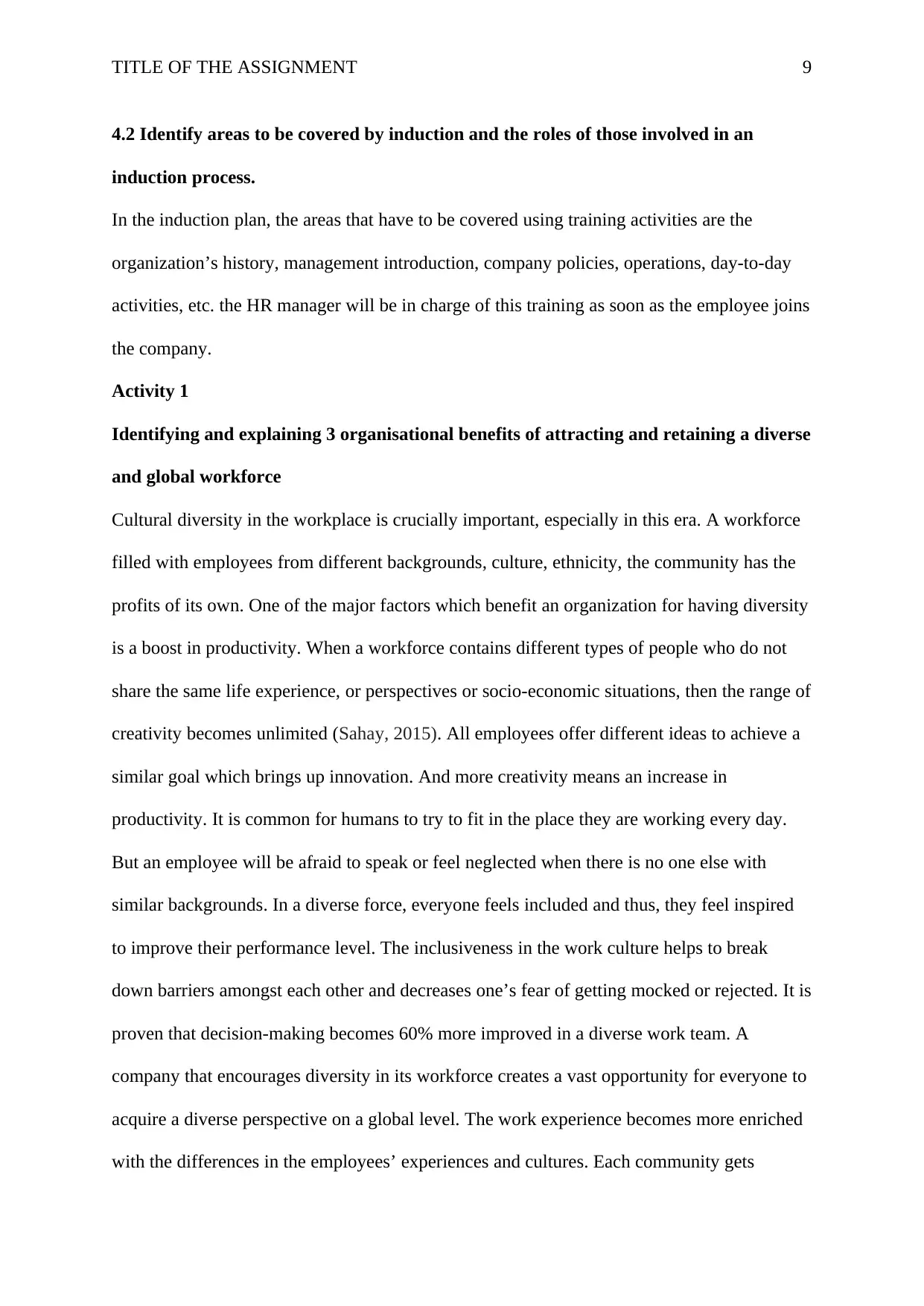
TITLE OF THE ASSIGNMENT 9
4.2 Identify areas to be covered by induction and the roles of those involved in an
induction process.
In the induction plan, the areas that have to be covered using training activities are the
organization’s history, management introduction, company policies, operations, day-to-day
activities, etc. the HR manager will be in charge of this training as soon as the employee joins
the company.
Activity 1
Identifying and explaining 3 organisational benefits of attracting and retaining a diverse
and global workforce
Cultural diversity in the workplace is crucially important, especially in this era. A workforce
filled with employees from different backgrounds, culture, ethnicity, the community has the
profits of its own. One of the major factors which benefit an organization for having diversity
is a boost in productivity. When a workforce contains different types of people who do not
share the same life experience, or perspectives or socio-economic situations, then the range of
creativity becomes unlimited (Sahay, 2015). All employees offer different ideas to achieve a
similar goal which brings up innovation. And more creativity means an increase in
productivity. It is common for humans to try to fit in the place they are working every day.
But an employee will be afraid to speak or feel neglected when there is no one else with
similar backgrounds. In a diverse force, everyone feels included and thus, they feel inspired
to improve their performance level. The inclusiveness in the work culture helps to break
down barriers amongst each other and decreases one’s fear of getting mocked or rejected. It is
proven that decision-making becomes 60% more improved in a diverse work team. A
company that encourages diversity in its workforce creates a vast opportunity for everyone to
acquire a diverse perspective on a global level. The work experience becomes more enriched
with the differences in the employees’ experiences and cultures. Each community gets
4.2 Identify areas to be covered by induction and the roles of those involved in an
induction process.
In the induction plan, the areas that have to be covered using training activities are the
organization’s history, management introduction, company policies, operations, day-to-day
activities, etc. the HR manager will be in charge of this training as soon as the employee joins
the company.
Activity 1
Identifying and explaining 3 organisational benefits of attracting and retaining a diverse
and global workforce
Cultural diversity in the workplace is crucially important, especially in this era. A workforce
filled with employees from different backgrounds, culture, ethnicity, the community has the
profits of its own. One of the major factors which benefit an organization for having diversity
is a boost in productivity. When a workforce contains different types of people who do not
share the same life experience, or perspectives or socio-economic situations, then the range of
creativity becomes unlimited (Sahay, 2015). All employees offer different ideas to achieve a
similar goal which brings up innovation. And more creativity means an increase in
productivity. It is common for humans to try to fit in the place they are working every day.
But an employee will be afraid to speak or feel neglected when there is no one else with
similar backgrounds. In a diverse force, everyone feels included and thus, they feel inspired
to improve their performance level. The inclusiveness in the work culture helps to break
down barriers amongst each other and decreases one’s fear of getting mocked or rejected. It is
proven that decision-making becomes 60% more improved in a diverse work team. A
company that encourages diversity in its workforce creates a vast opportunity for everyone to
acquire a diverse perspective on a global level. The work experience becomes more enriched
with the differences in the employees’ experiences and cultures. Each community gets
⊘ This is a preview!⊘
Do you want full access?
Subscribe today to unlock all pages.

Trusted by 1+ million students worldwide

TITLE OF THE ASSIGNMENT 10
affected when an organization brings changes in an employee’s life. Thus, communication
with diverse surroundings becomes easier for the company and enables them to connect to a
larger and diverse market globally (Micik & Eger, 2015). The company can develop its
market growth nationally and internationally.
Identifying and explaining 4 factors that affect a global organisation’s approach to
attracting talent
The economic environment is one such factor. When the economy is down, markets are filled
with talented people who are unemployed. In that situation, a company will have many
options for hiring employees who are way above their required skills or talents. Besides, the
company also recruits many workers in such a situation with no issue. When the economy
turns up, markets are filled with jobs. Then an employee may feel the need to quit a current
job unless there is an opportunity for self-development or salary increase (Kigo & Gachunga,
2016).
Training and development is the second factor. A company with informative training sessions
along with educational learning is bound to attract employees who are eager to learn at work
and to improve their skills. The development will mean the employees having chances to
improve their careers by moving up in their designations. If there are opportunities for
promotions, the candidates are less likely to leave the company ever. Thus, companies can
retain their valuable workers.
As per the Equality Act 2010, no company can discriminate against a person based on their
age or gender or race or physical ability. Therefore, the companies have to shape their
approach which will be inclusive and will not contain any specification or job description to
portray bias, objectivity or prejudice (Saadat & Eskandari, 2016).
The benefits package is given to employees as an additional value for their work contribution.
If a package is more flexible on several factors and can be altered from person to person
affected when an organization brings changes in an employee’s life. Thus, communication
with diverse surroundings becomes easier for the company and enables them to connect to a
larger and diverse market globally (Micik & Eger, 2015). The company can develop its
market growth nationally and internationally.
Identifying and explaining 4 factors that affect a global organisation’s approach to
attracting talent
The economic environment is one such factor. When the economy is down, markets are filled
with talented people who are unemployed. In that situation, a company will have many
options for hiring employees who are way above their required skills or talents. Besides, the
company also recruits many workers in such a situation with no issue. When the economy
turns up, markets are filled with jobs. Then an employee may feel the need to quit a current
job unless there is an opportunity for self-development or salary increase (Kigo & Gachunga,
2016).
Training and development is the second factor. A company with informative training sessions
along with educational learning is bound to attract employees who are eager to learn at work
and to improve their skills. The development will mean the employees having chances to
improve their careers by moving up in their designations. If there are opportunities for
promotions, the candidates are less likely to leave the company ever. Thus, companies can
retain their valuable workers.
As per the Equality Act 2010, no company can discriminate against a person based on their
age or gender or race or physical ability. Therefore, the companies have to shape their
approach which will be inclusive and will not contain any specification or job description to
portray bias, objectivity or prejudice (Saadat & Eskandari, 2016).
The benefits package is given to employees as an additional value for their work contribution.
If a package is more flexible on several factors and can be altered from person to person
Paraphrase This Document
Need a fresh take? Get an instant paraphrase of this document with our AI Paraphraser
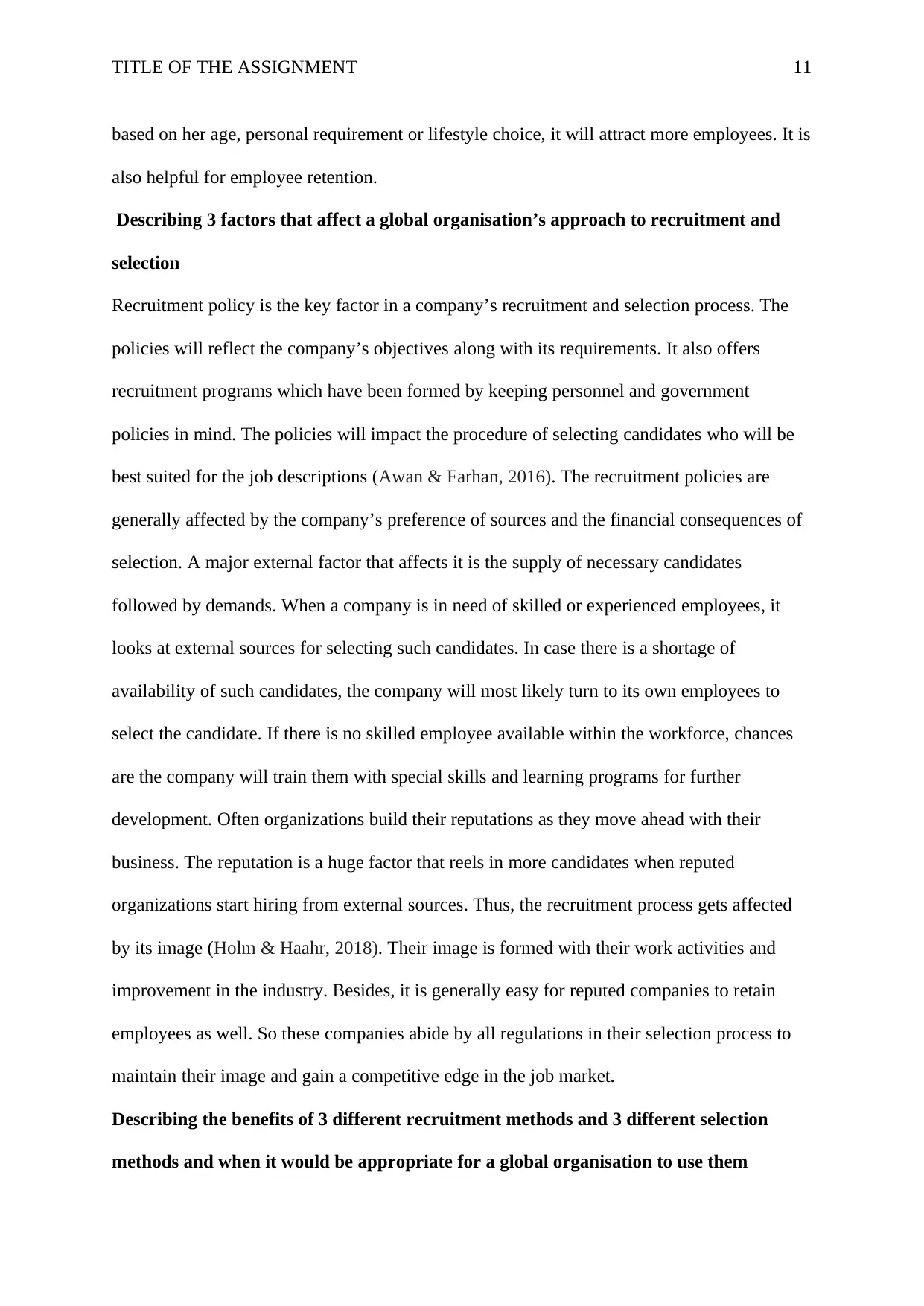
TITLE OF THE ASSIGNMENT 11
based on her age, personal requirement or lifestyle choice, it will attract more employees. It is
also helpful for employee retention.
Describing 3 factors that affect a global organisation’s approach to recruitment and
selection
Recruitment policy is the key factor in a company’s recruitment and selection process. The
policies will reflect the company’s objectives along with its requirements. It also offers
recruitment programs which have been formed by keeping personnel and government
policies in mind. The policies will impact the procedure of selecting candidates who will be
best suited for the job descriptions (Awan & Farhan, 2016). The recruitment policies are
generally affected by the company’s preference of sources and the financial consequences of
selection. A major external factor that affects it is the supply of necessary candidates
followed by demands. When a company is in need of skilled or experienced employees, it
looks at external sources for selecting such candidates. In case there is a shortage of
availability of such candidates, the company will most likely turn to its own employees to
select the candidate. If there is no skilled employee available within the workforce, chances
are the company will train them with special skills and learning programs for further
development. Often organizations build their reputations as they move ahead with their
business. The reputation is a huge factor that reels in more candidates when reputed
organizations start hiring from external sources. Thus, the recruitment process gets affected
by its image (Holm & Haahr, 2018). Their image is formed with their work activities and
improvement in the industry. Besides, it is generally easy for reputed companies to retain
employees as well. So these companies abide by all regulations in their selection process to
maintain their image and gain a competitive edge in the job market.
Describing the benefits of 3 different recruitment methods and 3 different selection
methods and when it would be appropriate for a global organisation to use them
based on her age, personal requirement or lifestyle choice, it will attract more employees. It is
also helpful for employee retention.
Describing 3 factors that affect a global organisation’s approach to recruitment and
selection
Recruitment policy is the key factor in a company’s recruitment and selection process. The
policies will reflect the company’s objectives along with its requirements. It also offers
recruitment programs which have been formed by keeping personnel and government
policies in mind. The policies will impact the procedure of selecting candidates who will be
best suited for the job descriptions (Awan & Farhan, 2016). The recruitment policies are
generally affected by the company’s preference of sources and the financial consequences of
selection. A major external factor that affects it is the supply of necessary candidates
followed by demands. When a company is in need of skilled or experienced employees, it
looks at external sources for selecting such candidates. In case there is a shortage of
availability of such candidates, the company will most likely turn to its own employees to
select the candidate. If there is no skilled employee available within the workforce, chances
are the company will train them with special skills and learning programs for further
development. Often organizations build their reputations as they move ahead with their
business. The reputation is a huge factor that reels in more candidates when reputed
organizations start hiring from external sources. Thus, the recruitment process gets affected
by its image (Holm & Haahr, 2018). Their image is formed with their work activities and
improvement in the industry. Besides, it is generally easy for reputed companies to retain
employees as well. So these companies abide by all regulations in their selection process to
maintain their image and gain a competitive edge in the job market.
Describing the benefits of 3 different recruitment methods and 3 different selection
methods and when it would be appropriate for a global organisation to use them
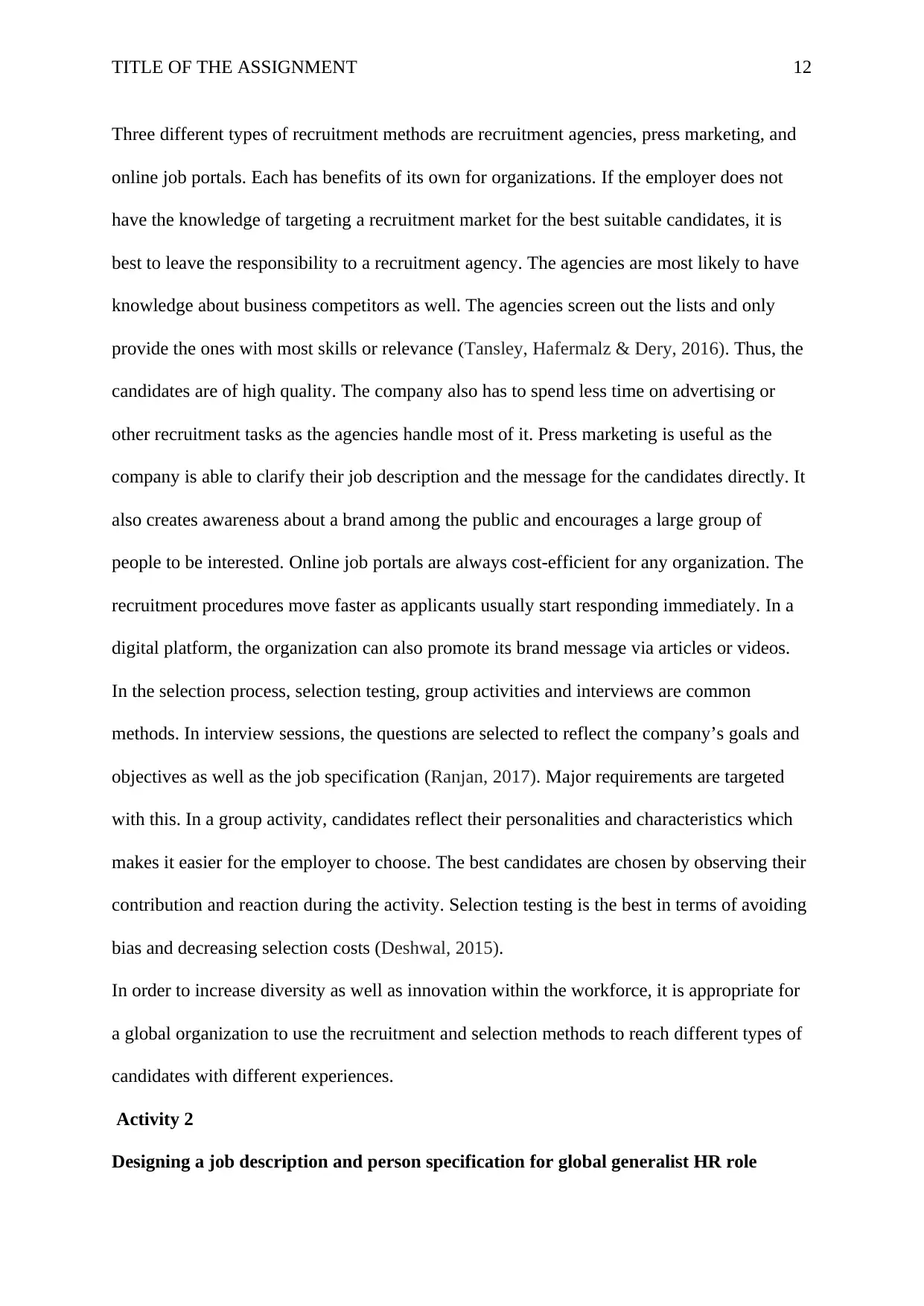
TITLE OF THE ASSIGNMENT 12
Three different types of recruitment methods are recruitment agencies, press marketing, and
online job portals. Each has benefits of its own for organizations. If the employer does not
have the knowledge of targeting a recruitment market for the best suitable candidates, it is
best to leave the responsibility to a recruitment agency. The agencies are most likely to have
knowledge about business competitors as well. The agencies screen out the lists and only
provide the ones with most skills or relevance (Tansley, Hafermalz & Dery, 2016). Thus, the
candidates are of high quality. The company also has to spend less time on advertising or
other recruitment tasks as the agencies handle most of it. Press marketing is useful as the
company is able to clarify their job description and the message for the candidates directly. It
also creates awareness about a brand among the public and encourages a large group of
people to be interested. Online job portals are always cost-efficient for any organization. The
recruitment procedures move faster as applicants usually start responding immediately. In a
digital platform, the organization can also promote its brand message via articles or videos.
In the selection process, selection testing, group activities and interviews are common
methods. In interview sessions, the questions are selected to reflect the company’s goals and
objectives as well as the job specification (Ranjan, 2017). Major requirements are targeted
with this. In a group activity, candidates reflect their personalities and characteristics which
makes it easier for the employer to choose. The best candidates are chosen by observing their
contribution and reaction during the activity. Selection testing is the best in terms of avoiding
bias and decreasing selection costs (Deshwal, 2015).
In order to increase diversity as well as innovation within the workforce, it is appropriate for
a global organization to use the recruitment and selection methods to reach different types of
candidates with different experiences.
Activity 2
Designing a job description and person specification for global generalist HR role
Three different types of recruitment methods are recruitment agencies, press marketing, and
online job portals. Each has benefits of its own for organizations. If the employer does not
have the knowledge of targeting a recruitment market for the best suitable candidates, it is
best to leave the responsibility to a recruitment agency. The agencies are most likely to have
knowledge about business competitors as well. The agencies screen out the lists and only
provide the ones with most skills or relevance (Tansley, Hafermalz & Dery, 2016). Thus, the
candidates are of high quality. The company also has to spend less time on advertising or
other recruitment tasks as the agencies handle most of it. Press marketing is useful as the
company is able to clarify their job description and the message for the candidates directly. It
also creates awareness about a brand among the public and encourages a large group of
people to be interested. Online job portals are always cost-efficient for any organization. The
recruitment procedures move faster as applicants usually start responding immediately. In a
digital platform, the organization can also promote its brand message via articles or videos.
In the selection process, selection testing, group activities and interviews are common
methods. In interview sessions, the questions are selected to reflect the company’s goals and
objectives as well as the job specification (Ranjan, 2017). Major requirements are targeted
with this. In a group activity, candidates reflect their personalities and characteristics which
makes it easier for the employer to choose. The best candidates are chosen by observing their
contribution and reaction during the activity. Selection testing is the best in terms of avoiding
bias and decreasing selection costs (Deshwal, 2015).
In order to increase diversity as well as innovation within the workforce, it is appropriate for
a global organization to use the recruitment and selection methods to reach different types of
candidates with different experiences.
Activity 2
Designing a job description and person specification for global generalist HR role
⊘ This is a preview!⊘
Do you want full access?
Subscribe today to unlock all pages.

Trusted by 1+ million students worldwide
1 out of 28
Related Documents
Your All-in-One AI-Powered Toolkit for Academic Success.
+13062052269
info@desklib.com
Available 24*7 on WhatsApp / Email
![[object Object]](/_next/static/media/star-bottom.7253800d.svg)
Unlock your academic potential
Copyright © 2020–2025 A2Z Services. All Rights Reserved. Developed and managed by ZUCOL.





